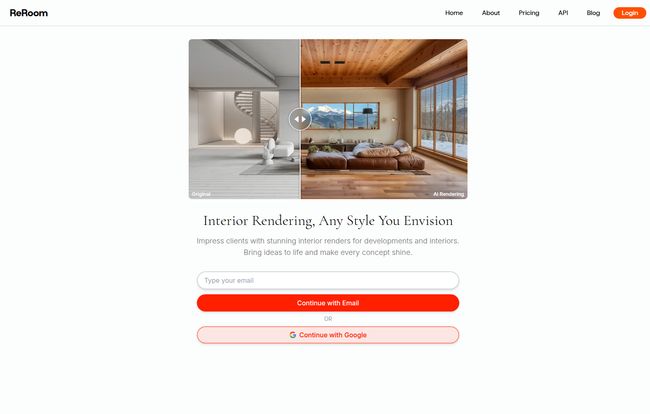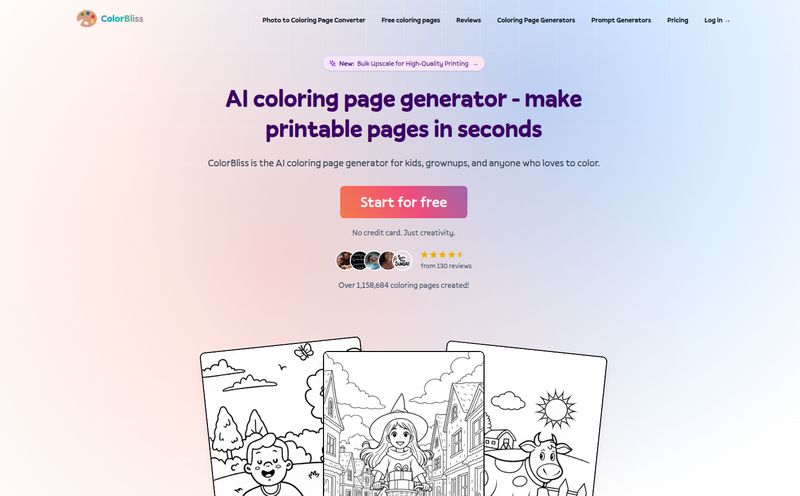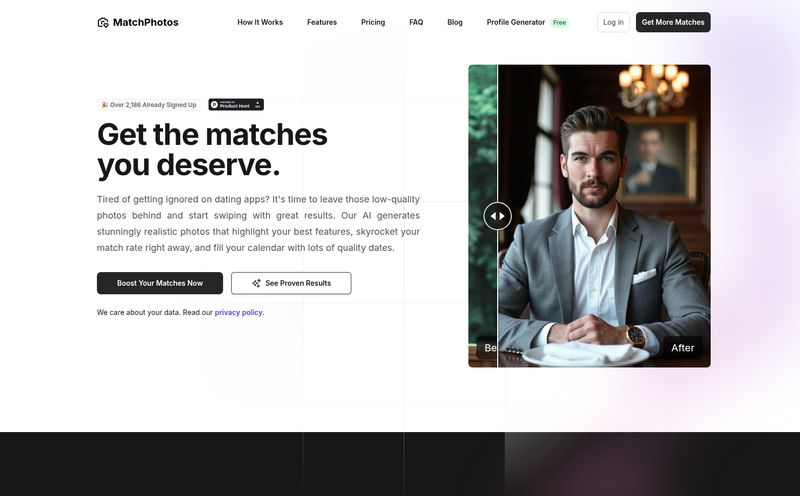If you've ever tried to redecorate a room, you know the pain. You spend hours, maybe even days, creating the perfect mood board on Pinterest. You've got a folder full of screenshots, a stack of paint swatches that all start to look the same after a while, and a vague notion of what you want. But when you try to explain it to your partner, your contractor, or even just yourself, you're met with that dreaded phrase: "I just can't picture it."
It's the eternal struggle of interior design. The gap between the vision in your head and the reality of the room is a chasm. For years, the only bridge was expensive, time-consuming 3D modeling software or, you know, just buying the furniture and hoping for the best (a risky game, my friends).
But now, a new wave of AI tools is crashing onto the scene, promising to close that gap. One of the names making waves is ReRoom AI. As someone who lives and breathes digital tools, I've seen my fair share of AI hype. So, naturally, I was skeptical. Another tool promising the world? But I have to say, after spending some time with it, ReRoom AI has a certain magic that’s hard to ignore.
So What Exactly is ReRoom AI?
At its core, ReRoom AI is an AI-powered visualization tool for interior spaces. That's the simple pitch. You feed it a picture of your room—your boring, empty, or just plain outdated living room—and you tell it what you want. It's like having an impossibly fast interior designer on retainer, one who speaks in images instead of jargon. It takes your photo and, within seconds, spits back a photorealistic render of what that same room could look like in a completely different style. No complex software, no learning curve, just… results.
Getting Started with ReRoom AI (It's Almost Too Easy)
The process is so straightforward it almost feels like a trick. You upload a photo of your space. It can be a messy bedroom, a vacant office, whatever. Then, you get to play. You choose from over 20 different design styles. We're talking everything from sleek Minimalist and cozy Scandinavian to bold Art Deco and earthy Bohemian. You click a button. And you wait. But you don't wait long.
It's fast. Insanely fast. We're talking about a process that used to take professional 3D artists hours, if not days, crunched down into the time it takes to grab a glass of water. Suddenly, you're not just imagining your living room with a modern coastal vibe; you're looking at it.

Visit ReRoom AI
This speed is probably its biggest selling point for me. The ability to iterate without penalty is a creative superpower. Don't like the first one? Try another style. And another. You can explore dozens of possibilities before you ever have to pick up a paintbrush or add a single item to a shopping cart.
The Good, The Bad, and The AI-Generated Sofa
No tool is perfect, right? Every piece of software has its quirks. I like to think of it less as a list of pros and cons and more of a friendly chat about what works and what you should know before you jump in.
What I Really Liked About ReRoom AI
The speed and simplicity are obviously huge wins. It’s incredibly accessible. But what truly blew me away was the quality of the renders. This isn't some cartoonish mockup. The AI does a surprisingly good job of maintaining the core architecture of your room—the windows, the doors, the overall layout—while completely reimagining the furniture, colors, and textures. The results are genuinely photorealistic. For professionals, the features locked behind the paid plans are where the real value is. Getting commercial usage rights is massive. That means a designer or real estate agent can confidently use these images in client presentations or marketing materials. Watermark-free renders, image upscaling for higher quality, and advanced prompt-based customization give you the control you need to go from a fun experiment to a serious business tool.
A Few Things to Keep in Mind
Okay, let's talk about the trial plan. It's free, which is great, but it's very much a trial. Your renders will have a watermark, and you're limited in your daily use. That's fair, in my opinion. They're giving you a real taste of the engine without asking for a credit card. It’s enough to see if the tool is right for you. Naturally, the most powerful features are reserved for paying customers. That's just the business model of pretty much every SaaS platform today. So if you need things like video generation credits or advanced rendering modes, you'll have to open your wallet. And yes, like every other website built since the dawn of GDPR, it asks for cookie acceptance. A small price to pay for design magic, I suppose.
Let’s Talk Money: ReRoom AI Pricing Explained
The pricing structure is actually one of the things I think ReRoom AI gets right. It’s tiered in a way that makes sense for different types of users. They’re not trying to push a one-size-fits-all solution.
| Plan Type | Price | Best For |
|---|---|---|
| Trial Plan | $0 | Curious individuals and DIYers wanting to test the platform. |
| Monthly Plan | $25 / month | Small teams or solo professionals needing flexibility. |
| Annually Plan | $21 / month | Professionals committing for the long term to save money. |
| Student Plans | Starting from $5 / two weeks | Students with a valid education email. |
For the Curious and DIYers
The $0 Trial Plan is your entry point. You get a feel for the core tools, but with the limitations we discussed. It's perfect for a weekend redecorating project or just to satisfy your curiosity.
For the Solo Pro or Small Agency
Here you have the Monthly Plan ($25/mo) and the better-value Annually Plan ($21/mo). This is the sweet spot for most professionals. It unlocks all the good stuff: unlimited renders, commercial rights, no watermarks, and advanced controls. If you're using this to make money, this is the tier you need to be in.
For the Design Powerhouses
They also offer dedicated Team Plans (starting at $29/mo annually) that add crucial collaborative features. We’re talking shared projects, one-click invites, and team moodboards. The team plans... now these are for the big players, the agencies with multiple designers all needing access to the same projects and moodboards and its a smart system.
A Smart Move for Students
I have to give them credit for their Student Plans. With options like a bi-weekly plan for just $5, they're making their tool incredibly accessible to the next generation of designers. It’s a savvy move to build brand loyalty from the ground up.
Who is ReRoom AI Actually For?
After playing around, I see a few key people who would get a ton of value from this.
- The Homeowner: You're tired of guessing. You want to see what your living room would look like as a Japandi paradise before you commit. This is your tool. It's visual confirmation.
- The Interior Designer: You need to create quick, impressive visuals for clients to get buy-in on a concept. Instead of spending a day on a complex render, you can generate five different options in ten minutes during a client meeting. The included SketchUp Plugin Support is also a clear nod to the professional workflow.
- The Real Estate Agent or Developer: You have a vacant property that feels cold and uninviting. With ReRoom AI, you can virtually stage it in a dozen different ways to help potential buyers see the potential. It transforms an empty box into a home.
My Final Verdict on ReRoom AI
So, is ReRoom AI the future? In a way, yes. It's a powerful glimpse of what's to come. It's not going to replace the nuanced creativity and problem-solving skills of a great interior designer. But that's not the point. It's a tool. And a darn good one at that.
Think of it as a force multiplier. It takes the most time-consuming, tedious part of the design process—visualization—and automates it beautifully. This frees up human designers to focus on what they do best: understanding clients, space planning, and curating the perfect collection of pieces. For the average person, it demystifies design and makes it fun and accessible. Did it get every detail perfect every single time? Not always, but the hit rate was impressive, and the ability to just click 'generate' again is a low-stakes way to find something you love.
Frequently Asked Questions (FAQ)
Can I use the images from ReRoom AI for my business?
Yes, you can! But you'll need one of the paid plans (Monthly, Annually, or Team) which grant you full commercial usage rights for the images you create.
Is ReRoom AI difficult to learn?
Absolutely not. It's one of its biggest strengths. If you can upload a photo to social media, you have all the skills you need to get started. It's designed to be incredibly intuitive.
What happens if I don't like the design the AI creates?
Just try again! You can re-run the same style, pick a different style, or if you're on a paid plan, use text prompts to get more specific with your request. Iteration is fast and easy.
Is the student plan really that cheap?
It is. The student plans are heavily discounted to make the tool accessible for those in school. You'll need to sign up with a valid education email address (.edu or a similar domain) to qualify.
Does ReRoom AI work for kitchens and bathrooms?
Yes, it can. While many examples show living rooms and bedrooms, the AI can work on any interior space. It's particularly effective for visualizing new cabinet colors, backsplashes, or tile layouts.
Can I specify certain furniture or colors?
With the basic style-based generation, you have less direct control. However, the paid plans offer advanced options like prompt-based customization, where you can give the AI more specific instructions like "with a green velvet sofa and brass light fixtures."
Conclusion
In the ever-growing world of AI tools, ReRoom AI stands out for its simplicity, speed, and the sheer quality of its output. It successfully bridges the gap between imagination and visualization, making interior design more accessible for homeowners and more efficient for professionals. It’s not about replacing creativity; it’s about giving it a powerful new canvas to play on. If you're on the fence, the free trial is a no-brainer. Give it a shot—you might just find the inspiration you've been looking for.



